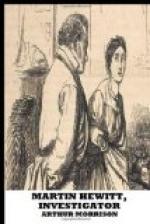“Well, Mr. Hewitt,” Nettings said, “this case has certainly been a shocking beating for me. I must have been as blind as a bat when I started on it. And yet I don’t see that you had a deal to go on, even now. What struck you first?”
“Well, in the beginning it seemed rather odd to me that the body should have been taken away, as I had been told it was, after the written paper had been pinned on it. Why should the murderer pin a label on the body of his victim if he meant carrying that body away? Who would read the label and learn of the nature of the revenge gratified? Plainly, that indicated that the person who had carried away the body was not the person who had committed the murder. But as soon as I began to examine the place I saw the probability that there was no murder, after all. There were any number of indications of this fact, and I can’t understand your not observing them. First, although there was a good deal of blood on the floor just below where the housemaid had seen Rameau lying, there was none between that place and the door. Now, if the body had been dragged, or even carried, to the door, blood must have become smeared about the floor, or at least there would have been drops, but there were none, and this seemed to hint that the corpse might have come to itself, sat up on the sofa, stanched the wound, and walked out. I reflected at once that Rameau was a full-blooded negro, and that a negro’s head is very nearly invulnerable to anything short of bullets. Then, if the body had been dragged out—as such a heavy body must have been—almost of necessity the carpet and rugs would show signs of the fact, but there were no such signs. But beyond these there was the fact that no long black overcoat was left with the other clothes, although the housekeeper distinctly remembered Rameau’s possession of such a garment. I judged he would use some such thing to assist his disguise, which was why I asked her. Why he would want to disguise was plain, as you shall see presently. There were no towels left in the bath-room; inference, used for bandages. Everything seemed to show that the only person responsible for Rameau’s removal was Rameau himself. Why, then, had he gone away secretly and hurriedly, without making complaint, and why had he stayed away? What reason would he have for doing this if it had been Goujon that had attacked him? None. Goujon was going to France. Clearly, Rameau was afraid of another attack from some implacable enemy whom he was anxious to avoid—one against whom he feared legal complaint or defense would be useless. This brought me at once to the paper found on the floor. If this were the work of Goujon and an open reference to his tortoise, why should he be at such pains to disguise his handwriting? He would have been already pointing himself out by the mere mention of the tortoise. And, if he could not avoid a shake in his natural, small handwriting, how could he have avoided it in a large, clumsy, slowly drawn, assumed hand? No, the paper was not Goujon’s.”




